实验要求
(一)基本要求
- 拓扑文件
#!/usr/bin/env python
from mininet.net import Mininet
from mininet.node import Controller, RemoteController, OVSController
from mininet.node import CPULimitedHost, Host, Node
from mininet.node import OVSKernelSwitch, UserSwitch
from mininet.node import IVSSwitch
from mininet.cli import CLI
from mininet.log import setLogLevel, info
from mininet.link import TCLink, Intf
from subprocess import call
def myNetwork():
net = Mininet( topo=None,
build=False,
ipBase='192.168.0.0/24')
info( '*** Adding controller\n' )
c0=net.addController(name='c0',
controller=Controller,
protocol='tcp',
port=6633)
info( '*** Add switches\n')
s1 = net.addSwitch('s1', cls=OVSKernelSwitch)
s2 = net.addSwitch('s2', cls=OVSKernelSwitch)
info( '*** Add hosts\n')
h1 = net.addHost('h1', cls=Host, ip='192.168.0.101/24', defaultRoute=None)
h2 = net.addHost('h2', cls=Host, ip='192.168.0.102/24', defaultRoute=None)
h3 = net.addHost('h3', cls=Host, ip='192.168.0.103/24', defaultRoute=None)
h4 = net.addHost('h4', cls=Host, ip='192.168.0.104/24', defaultRoute=None)
info( '*** Add links\n')
net.addLink(h1, s1)
net.addLink(h2, s1)
net.addLink(s1, s2)
net.addLink(s2, h3)
net.addLink(s2, h4)
info( '*** Starting network\n')
net.build()
info( '*** Starting controllers\n')
for controller in net.controllers:
controller.start()
info( '*** Starting switches\n')
net.get('s1').start([c0])
net.get('s2').start([c0])
info( '*** Post configure switches and hosts\n')
CLI(net)
net.stop()
if __name__ == '__main__':
setLogLevel( 'info' )
myNetwork()
- 查看抓包结果,分析OpenFlow协议中交换机与控制器的消息交互过程,画出相关交互图或流程图。
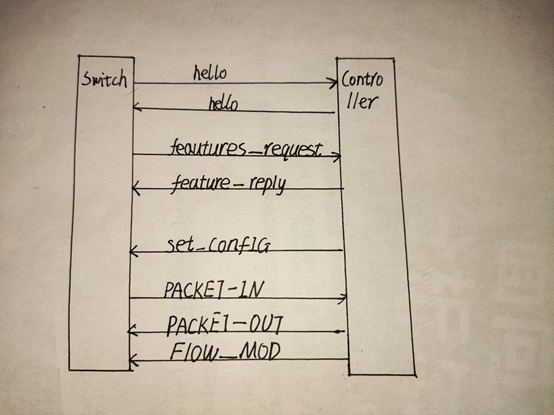
- HELLO
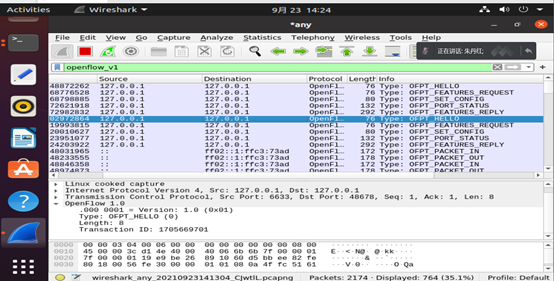
- SET_CONFIG
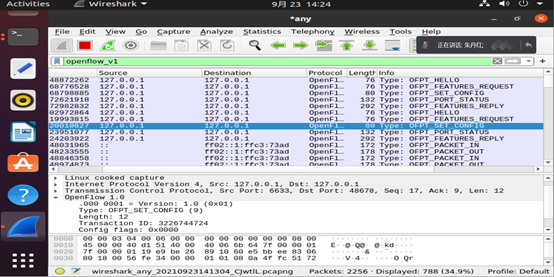
- FEATURES_REQUEST/FEATURES_REPLY

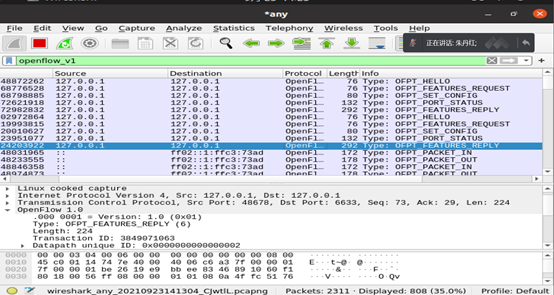
- PORT_STATUS
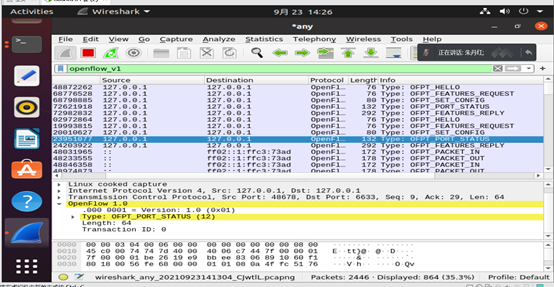
- PACKET_IN

- PACKET_OUT

- FLOW_MOD

- 回答问题:交换机与控制器建立通信时是使用TCP协议还是UDP协议?
答:从抓包内容中看出采用的协议是TCP协议
(二)、进阶要求
打开相关数据结构可在openflow安装目录openflow/include/openflow当中的openflow.h头文件中查询到。
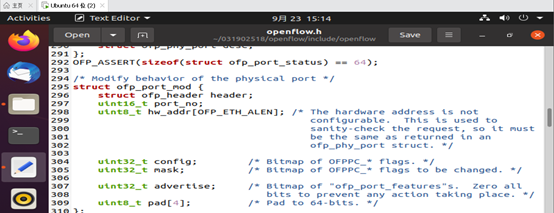
- HELLO

struct ofp_header {
uint8_t version; /* OFP_VERSION. */
uint8_t type; /* One of the OFPT_ constants. */
uint16_t length; /* Length including this ofp_header. */
uint32_t xid; /* Transaction id associated with this packet.
Replies use the same id as was in the request
to facilitate pairing. */
};
struct ofp_hello {
struct ofp_header header;
};
可以看到参数数量一致
- FEATURES_REQUEST
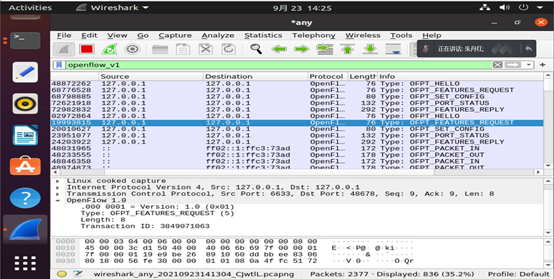
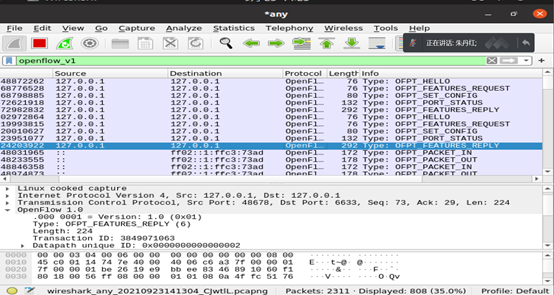
struct ofp_switch_features {
struct ofp_header header;
uint64_t datapath_id; /* Datapath unique ID. The lower 48-bits are for
a MAC address, while the upper 16-bits are
implementer-defined. */
uint32_t n_buffers; /* Max packets buffered at once. */
uint8_t n_tables; /* Number of tables supported by datapath. */
uint8_t pad[3]; /* Align to 64-bits. */
/* Features. */
uint32_t capabilities; /* Bitmap of support "ofp_capabilities". */
uint32_t actions; /* Bitmap of supported "ofp_action_type"s. */
/* Port info.*/
struct ofp_phy_port ports[0]; /* Port definitions. The number of ports
is inferred from the length field in
the header. */
};
/* Description of a physical port */
struct ofp_phy_port {
uint16_t port_no;
uint8_t hw_addr[OFP_ETH_ALEN];
char name[OFP_MAX_PORT_NAME_LEN]; /* Null-terminated */
uint32_t config; /* Bitmap of OFPPC_* flags. */
uint32_t state; /* Bitmap of OFPPS_* flags. */
/* Bitmaps of OFPPF_* that describe features. All bits zeroed if
* unsupported or unavailable. */
uint32_t curr; /* Current features. */
uint32_t advertised; /* Features being advertised by the port. */
uint32_t supported; /* Features supported by the port. */
uint32_t peer; /* Features advertised by peer. */
};
- SET_CONFIG
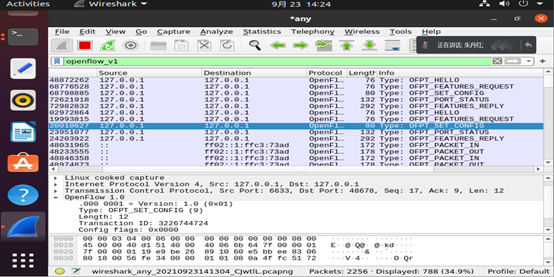
/* Switch configuration. */
struct ofp_switch_config {
struct ofp_header header;
uint16_t flags; /* OFPC_* flags. */
uint16_t miss_send_len; /* Max bytes of new flow that datapath should
send to the controller. */
};
- PORT_STATUS
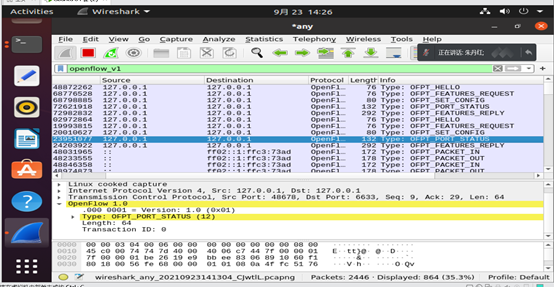
/* A physical port has changed in the datapath */
struct ofp_port_status {
struct ofp_header header;
uint8_t reason; /* One of OFPPR_*. */
uint8_t pad[7]; /* Align to 64-bits. */
struct ofp_phy_port desc;
};
- PACKET_IN

enum ofp_packet_in_reason {
OFPR_NO_MATCH, /* No matching flow. */
OFPR_ACTION /* Action explicitly output to controller. */
};
- PACKET_OUT
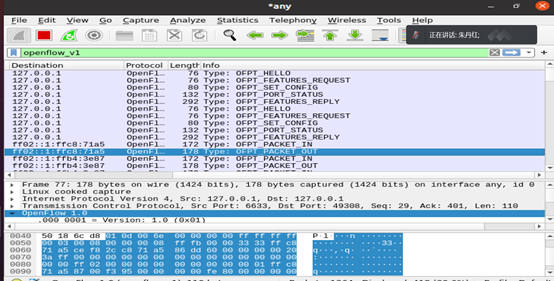
struct ofp_packet_out {
struct ofp_header header;
uint32_t buffer_id; /* ID assigned by datapath (-1 if none). */
uint16_t in_port; /* Packet's input port (OFPP_NONE if none). */
uint16_t actions_len; /* Size of action array in bytes. */
struct ofp_action_header actions[0]; /* Actions. */
/* uint8_t data[0]; */ /* Packet data. The length is inferred
from the length field in the header.
(Only meaningful if buffer_id == -1.) */
};
- FLOW_MOD
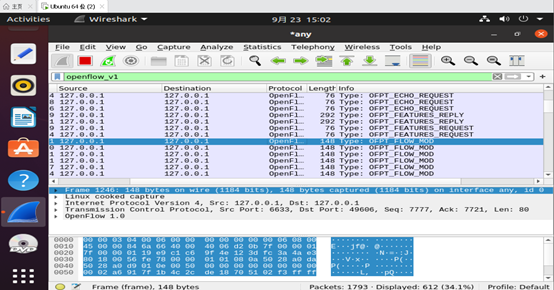
struct ofp_flow_mod {
struct ofp_header header;
struct ofp_match match; /* Fields to match */
uint64_t cookie; /* Opaque controller-issued identifier. */
/* Flow actions. */
uint16_t command; /* One of OFPFC_*. */
uint16_t idle_timeout; /* Idle time before discarding (seconds). */
uint16_t hard_timeout; /* Max time before discarding (seconds). */
uint16_t priority; /* Priority level of flow entry. */
uint32_t buffer_id; /* Buffered packet to apply to (or -1).
Not meaningful for OFPFC_DELETE*. */
uint16_t out_port; /* For OFPFC_DELETE* commands, require
matching entries to include this as an
output port. A value of OFPP_NONE
indicates no restriction. */
uint16_t flags; /* One of OFPFF_*. */
struct ofp_action_header actions[0]; /* The action length is inferred
from the length field in the
header. */
};
struct ofp_action_header {
uint16_t type; /* One of OFPAT_*. */
uint16_t len; /* Length of action, including this
header. This is the length of action,
including any padding to make it
64-bit aligned. */
uint8_t pad[4];
};
总结
1.实验中遇到的问题是flow mod需要在终端中执行pingall语句后才可以在wireshark中看到交互过程,我在终止拓扑运行后才发现这个问题,故重新运行后执行了pingall,故交换机的端口与之前有所不同。但我保证绝对是我一个人做出来的
2.之前一直找不到mod,以为自己之前的某些步骤做错了,后来问同学才知道,原因竟然是项目太少,很难找到。他推推荐我点上面的info。这样就可以进行排序。十分方便。
3.进阶要求阅读openflow.h中的代码对照抓包内容里的参数寻找源码代码实在是太多,就放到了word根据关键词查找相应的数据类型后再阅读相应部分的代码,看看相应部分代码是否有列出别的结构体
4.熟悉了 Wireshark 抓包,了解了 OpenFlow 协议的报文结构。通过报文信息对使用 OpenFlow 协议通信的过程进行分析,发现这里的交换机与传统的交换机不同,它的转发规则由流表指定,而流表由控制器发送,
5.这个实验让我明白了控制器为什么要叫控制器以及流表在 OpenFlow 协议中的重要性,尤其是当两个设备运用的协议不同时,因为OpenFlow向下兼容,所以选择最低版本的那个。让我明白了不同协议之间是如何运行的。


